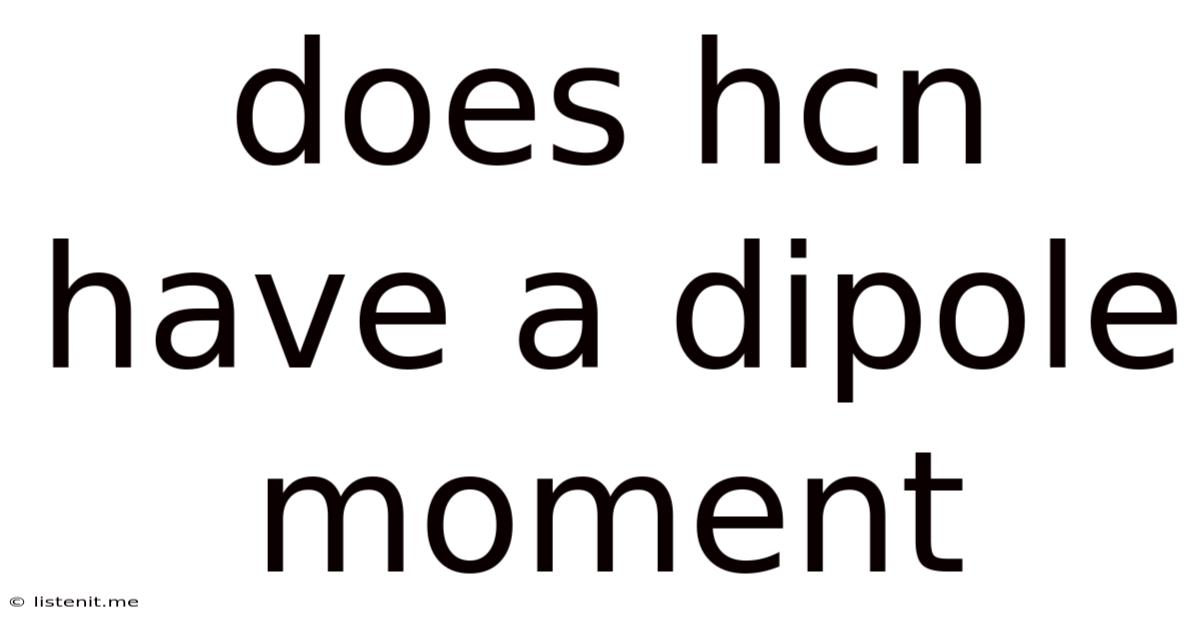Does Hcn Have A Dipole Moment
listenit
Jun 14, 2025 · 4 min read

Table of Contents
Does HCN Have a Dipole Moment? A Deep Dive into Molecular Polarity
Understanding molecular polarity, specifically the presence or absence of a dipole moment, is crucial in chemistry. It dictates how molecules interact with each other and their environment, influencing properties like boiling point, solubility, and reactivity. This article delves into the question: Does HCN (hydrogen cyanide) have a dipole moment? We'll explore the concept of dipole moments, the molecular geometry of HCN, and the electronegativity differences that contribute to its overall polarity.
Understanding Dipole Moments
A dipole moment arises when there's an uneven distribution of electron density within a molecule. This occurs due to differences in electronegativity between atoms. Electronegativity is the ability of an atom to attract electrons towards itself in a chemical bond. When atoms with significantly different electronegativities bond, the more electronegative atom pulls the shared electrons closer, creating a partial negative charge (δ-) on that atom and a partial positive charge (δ+) on the less electronegative atom. This separation of charge creates an electric dipole, measured in Debye (D).
A molecule can have a net dipole moment even if it contains individual polar bonds. The overall dipole moment is the vector sum of the individual bond dipoles. If these bond dipoles cancel each other out due to symmetry, the molecule will have a zero dipole moment, even though individual bonds are polar.
The Molecular Structure of HCN
Hydrogen cyanide (HCN) is a linear molecule. This means all three atoms (H, C, and N) lie along a straight line. Its Lewis structure shows a triple bond between carbon and nitrogen and a single bond between hydrogen and carbon:
H-C≡N
This linear arrangement is crucial in determining whether HCN possesses a dipole moment.
Electronegativity Differences in HCN
The electronegativity values of the atoms in HCN are:
- Hydrogen (H): Approximately 2.2
- Carbon (C): Approximately 2.5
- Nitrogen (N): Approximately 3.0
There's a clear difference in electronegativity between the atoms. Nitrogen is the most electronegative, followed by carbon, and then hydrogen. This difference leads to polar bonds:
- C-H bond: The C-H bond is slightly polar, with carbon having a slightly stronger pull on the shared electrons.
- C≡N bond: The C≡N triple bond is significantly polar, with nitrogen pulling electrons much more strongly than carbon.
Vector Sum of Bond Dipoles in HCN
Since HCN is linear, the bond dipoles are aligned along the same axis. The dipole moment of the C-H bond points towards the carbon atom, and the dipole moment of the C≡N bond points towards the nitrogen atom. Because nitrogen is significantly more electronegative than carbon, the dipole moment of the C≡N bond is considerably larger than the C-H bond's dipole moment.
Therefore, the vector sum of these two bond dipoles does not cancel out. Instead, they add up resulting in a net dipole moment pointing towards the nitrogen atom. This indicates that HCN is a polar molecule.
Experimental Evidence for HCN's Dipole Moment
The predicted polarity of HCN is supported by experimental measurements. The experimentally determined dipole moment of HCN is approximately 2.98 Debye. This value confirms the presence of a significant dipole moment, consistent with the electronegativity differences and linear molecular geometry.
Implications of HCN's Polarity
The polarity of HCN has several important implications:
- Solubility: HCN is slightly soluble in water due to its dipole moment, which allows it to interact with the polar water molecules through dipole-dipole interactions.
- Boiling Point: HCN has a higher boiling point than nonpolar molecules of comparable molecular weight due to dipole-dipole interactions between molecules.
- Reactivity: The polarity of HCN influences its reactivity. The partial charges on the atoms can affect the sites of electrophilic or nucleophilic attacks during chemical reactions.
- Spectroscopy: The dipole moment of HCN affects its behavior in various spectroscopic techniques, such as infrared (IR) and microwave spectroscopy.
Distinguishing Between Polar Bonds and Polar Molecules
It's crucial to understand the distinction between polar bonds and polar molecules. A molecule can have polar bonds but still be a nonpolar molecule if the bond dipoles cancel each other out due to symmetry, as seen in molecules like carbon dioxide (CO2) and methane (CH4). HCN, however, demonstrates that even with a slightly polar bond, the significant electronegativity difference in the triple bond creates an overall polar molecule.
Conclusion: HCN is Polar
In summary, yes, hydrogen cyanide (HCN) does possess a dipole moment. The significant electronegativity difference between carbon and nitrogen, coupled with the linear geometry of the molecule, results in a non-zero net dipole moment. This polarity has significant consequences for its physical and chemical properties, making understanding its dipole moment essential for comprehending its behavior. The experimentally determined dipole moment further confirms this conclusion. This understanding is fundamental to various chemical disciplines, emphasizing the importance of molecular geometry and electronegativity in determining the polarity of molecules. Further exploration of this topic could involve examining the effects of different solvents on the dipole moment of HCN or investigating the influence of temperature on its dipole moment.
Latest Posts
Latest Posts
-
What Does It Mean To Audit A Class
Jun 14, 2025
-
The Crucifixion Of Christ Verses Nails Through Hands
Jun 14, 2025
-
What Colour Is Power Steering Fluid
Jun 14, 2025
-
Kings Cross Train Station To St Pancras
Jun 14, 2025
-
How Long For A Hot Water Tank To Heat Up
Jun 14, 2025
Related Post
Thank you for visiting our website which covers about Does Hcn Have A Dipole Moment . We hope the information provided has been useful to you. Feel free to contact us if you have any questions or need further assistance. See you next time and don't miss to bookmark.